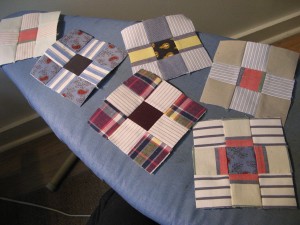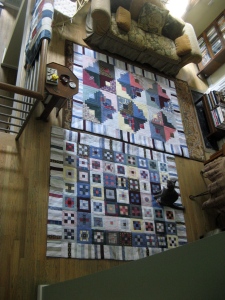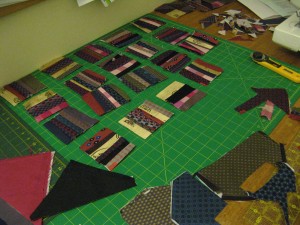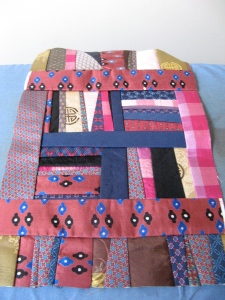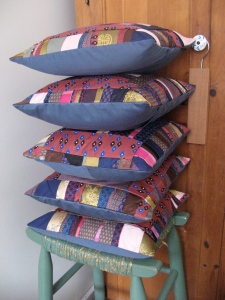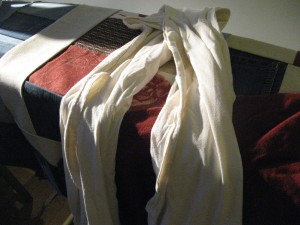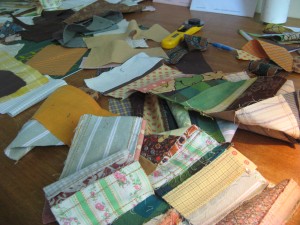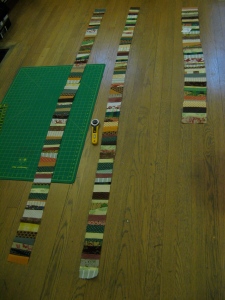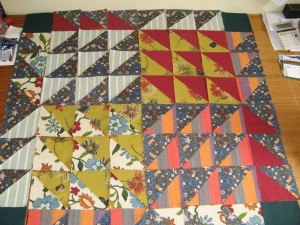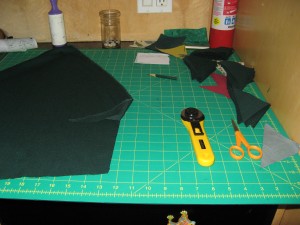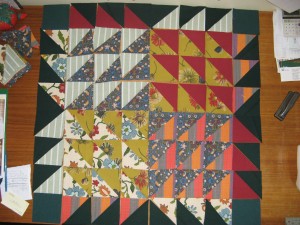This story starts with two little boys living in the Midwest. In addition to being pretty lucky in the parent department (example of a house rule: being read to is a right, not a privilege), they have an exceptionally dedicated grandmother, Sue. Sue is very involved with her grandsons, but is understandably rueful her husband died before he could know them. She wanted them to have something that would evoke him. This is where Patwig comes in.

Sue contributed more than 35 shirts for this project. After I cut up the first bunch (the stack in front) she sent more.
She wanted a twin sized quilt for each boy made from her husband’s old button-downs. Some were standard white formal fare, many sported various hues of blue, with and without stripes, and a few were appealing paisleys and plaids. After seeing sample Patwig Quilts, she chose the Nine-Patch block pattern and the Log Cabin pattern, which I hadn’t made before. That settled, she essentially gave me carte blanche to create, and I continued to be amazed at the trust people place in strangers.
Where to begin wasn’t hard to decide.

Log Cabin is a classic quilt block. A square sits at the center, (typically red), and rows of blocks are placed around it, one side light, one side dark.
I started with easy colors, as in the solid pairings above, and proceeded to more complex couplings, like the patterned lights and darks below

The red/pink and paisley here were among Sue's favorites
As blocks were completed I put them down on the floor to see light and dark create patterns.

The dark side is the strongest visual element here
I’d been working one block at a time until this point, and feeling assured that I was on the right track, shifted to mass production. This meant cutting 17 squares, 119 light blocks, 102 dark blocks and backing all with fusible interfacing.

A rotary cutter and grid mat make this more efficient, but it still takes time. Music helps.
Once all components were prepped, I sewed them together and put them down on the floor
until I arrived at this…

"Diamond in the Square" is another classic quilt pattern
With the Log Cabin blocks done, I was ready to turn to the second quiltop. Fortuitously, many cutting remnants offered a head start

The Nine-Patch ultimately required 567 two inch squares
Making the Nine-Patch was very enjoyable; each is an individual composition. This is the part I truly enjoy.
Once they began to multiply, I line them up en masse to see what they would do

More hodgepodge than medley
Moving to the floor, I added space between them

Much more distinct this way
Then each Nine-Patch got a border, all from button-down shirts
Steady production continued — sewing, pressing, sewing some more, until 63 Nine-Patch blocks each had a pressed border.
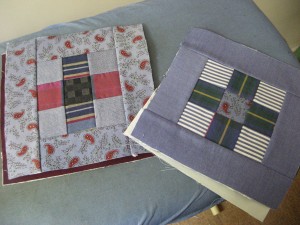
"Cute as a button" is a little precious, but I think it fits here
I was enjoying this small form stuff so much I’d forgotten the bigger picture — how they will form a quiltop:

Back on the floor

Going for 9 rows of 7

Next time I'll wear knee pads

All down, random placement.
How about alternating light and dark rows?

We have a winner
This is the midpoint. The primary design –the quiltop– is done. The rest is, shall we say, finish work (albeit with a decorative border). This is mostly assembly, but what it lacks in creativity it pays back in satisfaction as the finished piece slowly comes together.

Two stacks of quilt blocks
Individual blocks make a row, rows make a quiltop

I'm making more of an effort to get my corners "on point"

You can see the fusible interfacing on the backs here
A border brings each quilt up to twin size. I made a strip border drawing mostly from the white and striped button-downs.
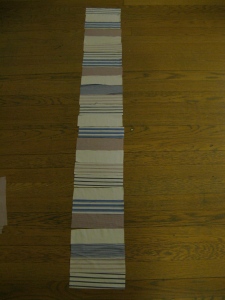
My son suggested adding more dark colors
After almost 300 two-by-seven inch strips were pressed, fused, sewn together and ironed, the quiltops are “framed”

A border on the Log Cabin really pops the diamonds out

This is my sixth Nine Patch quilt
Next up: batting (or fill) and backing. Sue has provided two full-sized sheets for the backing. Who can guess why this one has patchwork in the corners?

These sheets were repurposed twice: Sue had given them to a friend to use as drop cloths for painting before they got to me
Once the layers are sewn together and pressed (That sounds so breezy, doesn’t it? At about 65 by 82 inches, it took about an hour to seam each twice), I hand tie them together with yarn (another afternoon) with a nice light blue yarn I picked up for a song in Chinatown

A tapestry needle works best to pull the yarn through the layers, finished with a double knot.
This work takes place on the floor, where helpers stroll

Ursula is the only one of our cats that goes after yarn
Finished, side by side
Congratulations to you for making it all the way through this! I believe you are among a small, but attentive group of people. If there’s anyone you know whom you think might make it all the way as well, please send a link to this page to them, or post on your preferred social media.
Next post will be a Patwig Scrap Project.





























































